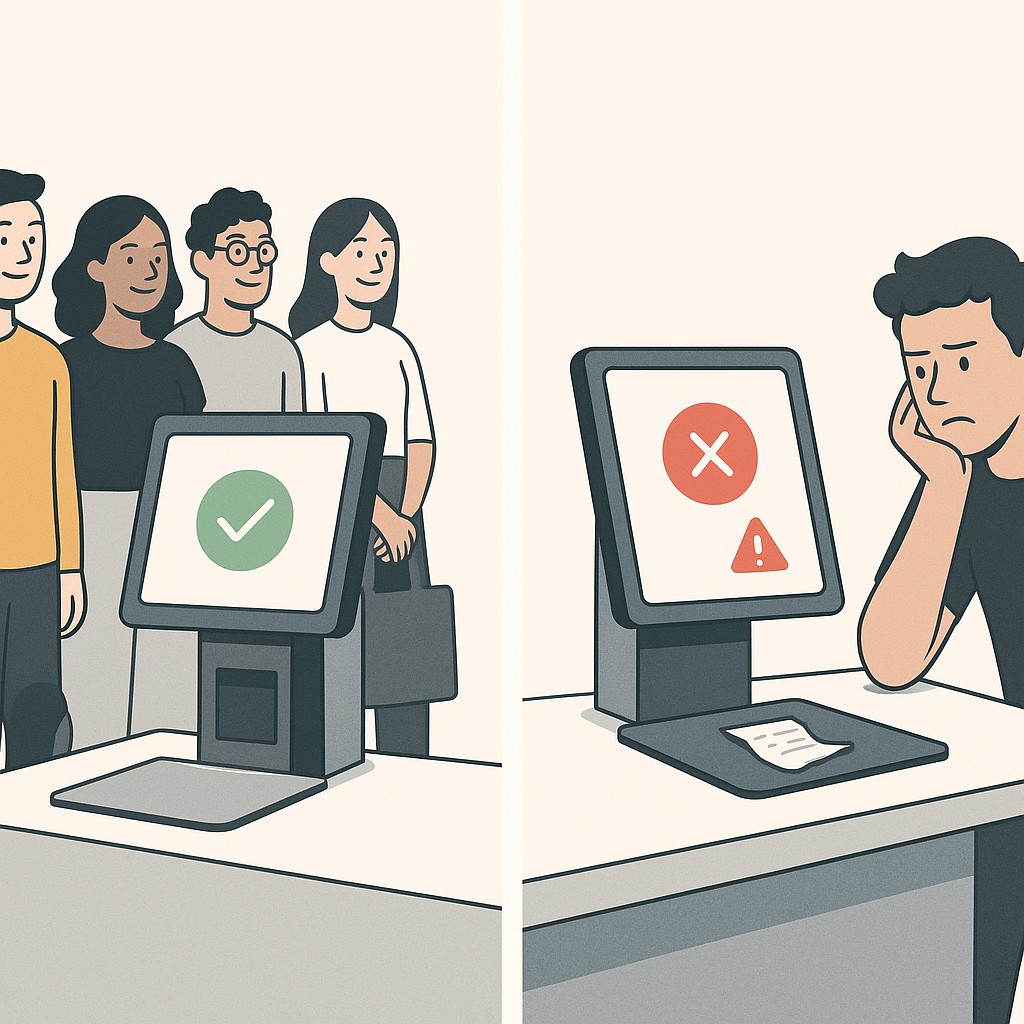Outcome-Focused Engineering Metrics: Effectiveness First, Efficiency Within Guardrails
Outcome-Focused Engineering Metrics: Effectiveness First, Efficiency Within Guardrails

Setting the Stage: Fast, Slow, and the Cost of Getting It Wrong
As we step into a new year, our whiteboards fill up fast. 2025 goals, resource maps, diagrams of bottlenecks circled in marker. At our kickoff, someone brings up two checkout designs from last quarter. One was lightning-fast, but sometimes double-billed customers or missed a discount. The other required a manager to approve every sale. Flawless, but every shopper waited. These extremes got us thinking: how are we actually going to measure progress on our 2025 goals before these sorts of trade-offs catch us off guard again?
Here’s where I always catch myself. Outcome-focused engineering metrics force the question: efficiency or effectiveness—are you solving the right problem? When a measure becomes a target, it stops being a good measure. The classic Goodhart’s Law reminds us just how slippery metrics can be.

Achieving both is ideal, but let’s face it, it’s rarely that simple. Lean too hard on speed or cost and you can ship a feature that “works”—as in, it runs—but doesn’t actually solve the user’s problem, or worse, causes new ones. That first checkout. We could demo it in less than a minute, but I spent more hours untangling refunds than actually learning from real usage.
Go the other way and you get the manager approval model. Accurate, but every launch feels like a slog and by the time you ship, the window’s closed or the team is deflated. I’ve seen whole quarters disappear to backlogs and process, only to realize we’re not even sure if we’ve moved the needle. Both patterns waste effort and obscure true progress, even though on paper they look disciplined.
So the challenge is clear. Anchor your decisions in the outcomes that matter—choose effectiveness over efficiency, and only then worry about making things efficient.
The Principle: Effectiveness Leads, Efficiency Follows
At the core, here’s how we work. Effectiveness is the north star, defining whether we’re actually achieving what matters. Efficiency is how smoothly we get there, but it stays within guardrails set by our primary goal.
Before anything else, you have to know why you’re doing the task. Take that checkout: speed looks great in a demo, but if the totals aren’t right, nothing else matters. Its true objective is accurate, reliable purchases. Everything else comes second.
So, step back. What’s the broader outcome your effort is meant to drive? If the immediate goal feels fuzzy or you’re lost in details, ask yourself: how does this ladder up to the bigger picture?
I used to gloss over this. There was a stretch (maybe two years ago now?) where I’d start sprints with “improve performance” as the headline. It always felt actionable until we sat down to demo and realized nobody was actually sure what better performance meant, or even who should care. It took some misses—embarrassing ones—to learn that naming outcomes up front saves everyone hours of circling later.
Once you’ve named that top-level goal, you can set real priorities by balancing efficiency and effectiveness. You might care most about speed, accuracy, or customer happiness. And you get to decide which comes first. That choice doesn’t only focus your team, it tells you what you’re willing to compromise on, and what you’re not.
Loop it back to those two checkout extremes—outcome-focused engineering metrics reveal when we’re optimizing the wrong thing. We failed when we optimized for the wrong thing in isolation. The fix is operationalizing this idea. Metrics done right anchor you in outcomes, not just activities. Even the pros cap their key metrics. Kohavi et al. recommend no more than five, to avoid drowning in noise and comparison traps. This way, you’re building clarity and impact right into your planning, not just hoping it works out later.
Choosing Outcome-Focused Engineering Metrics: Practical Guidance for 2025 Goals
Start with the basics—set outcome metrics first by framing every 2025 team goal in a single, unapologetically clear sentence. “Reduce onboarding time for new users by half.” “Ship a personalized recommendations engine that actually drives repeat usage.” Once that’s sharp, pick your one primary effectiveness metric. It’s your direct line from intention to customer impact. This is not an activity tracker or an indirect output. The magic of a primary metric is that it tells you, bluntly, if the project is a win or not. Secondary metrics are for the side effects—the “oh, wait” moments. Primary metrics tell you if the project succeeds, but secondary metrics catch those knock-on effects and unexpected impacts that ripple through your product.
Getting buy-in on these isn’t just about sending over a dashboard. Sync up in a standup, drop your objectives in a living doc, or put the metric in your sprint kickoff slide. Whatever the ritual, the key is to get your team and metrics focused on what matters most.
Look, setting up metrics—this is going to sound a bit off, but stick with me—reminds me of the time I reorganized my closet over a weekend. I got tired of never really knowing what I had, and even though it felt silly to label the shelves (“jeans,” “shirts,” honestly overkill), for a few weeks it completely changed how fast I could get dressed. Eventually I fell back to my old habits, shirts mingling with sweaters, and lost a bit of the clarity. The labels made everything obvious, but only as long as I kept using them. Building out metrics works the same way. The benefit is real, but you have to keep checking yourself before letting entropy creep back.
Then, define your efficiency guardrails as the secondary metric. This isn’t optional. The constraint is what keeps progress from quietly causing new problems. Think latency thresholds for product teams (checkout must feel instant), infra costs kept within a set percent of revenue for platform teams, or capping retraining time for ML models so improvements don’t dry up budgets. When you know where the upper or lower bounds are, you give the team permission to push, but with clear warning signs if things are going off track.
No need to drown in KPI soup. Two metrics—effectiveness and efficiency—per goal is enough to reduce noise, spotlight trade-offs, and make decisions confidently.
Translating Metrics to Execution: Rituals, Dashboards, and Reassessment
Quarterly reassessment isn’t just calendar noise. It’s the anchor that recalibrates your metrics before real-world context drifts or the “we’re busy” inertia takes over. We schedule these reviews now, not just to check a box, but to turn retros into change because what worked yesterday may not work tomorrow. It’s a simple way to call out fuzzy priorities or misaligned progress before dozens of sprints pass and the gap grows.
Bring your metrics into decision meetings, not just after something’s shipped. The primary outcome gets top billing. If a trade-off puts it at risk, escalate right away. This is how you turn vague worry (“is this good enough?”) into a structured call.
For me, instrumenting dashboards was about engineering success metrics, not tracking every possible number. It was about building proactive visibility systems that let you see effectiveness and efficiency side by side, with customer impact signals layered in. You want one view where green lights for throughput never obscure a flashing red for reliability or a sudden drop in user satisfaction.
Concrete helps here. This week, take one goal you have for the year and define the metrics you’ll use to measure success. Don’t wait for the next planning cycle. Test your approach on something real, and you’ll know if your metrics actually anchor decisions or just decorate the deck.
Let’s walk through this with a platform team example. Make reliability your primary metric. It could be uptime, error rate, or customer support tickets. Deployment throughput is your secondary metric (how many changes ship per week), but set guardrails for ship fast vs refine tradeoffs so speed never overtakes stability. The dashboard shows both, and every quarter you review if the balance still fits your actual needs. The team can push faster when reliability is solid; if outages spike, the system forces a pause. That’s what keeps progress outcome-based rather than just activity-driven, giving you momentum without hidden mess.
Addressing Doubts: Outcome-Based Progress in Practice
It’s normal to worry that spending time on clearer objectives and metrics might slow everything down, or that picking the “perfect” metrics now will backfire as things shift later. If you’re feeling that hesitation, you’re not alone—every team I’ve worked with wrestled with this.
Here’s why the extra effort pays off. When we anchor our work to the actual customer impact, we cut down on cycles of rework, misfires, and endless tweaking. It’s the difference between tweaking a checkout for speed and actually getting the right totals. Aligning what we measure with what customers truly care about preserves real momentum.
Fast-but-wrong means untangling messes after the fact, which is wasted effort. Slow-but-right drags the team down, stalling progress until even clean launches lose their punch.
So this is the ask: adopt outcome-based engineering metrics. Trust that planning with outcomes in mind lets you make confident trade-offs. Don’t fear shifting context. When your metrics are tied to real goals, you can adjust guardrails as needed.
If you build software or AI and need clean, usable content fast, use our AI to draft specs, sprint updates, and docs that stay clear on goals, constraints, and outcomes, ready to share.
Of course, there are weeks when even the best-intentioned priorities blur, especially when projects overlap or numbers come in late. I wish I could say I always catch drift before it matters, but sometimes you only see the gap after you’re in it. That’s something I haven’t totally solved yet—maybe it’s just part of the process.
Today’s the best time to start. Pick one goal, define a clear effectiveness metric and an efficiency guardrail, and watch your team’s focus snap into place.
Enjoyed this post? For more insights on engineering leadership, mindful productivity, and navigating the modern workday, follow me on LinkedIn to stay inspired and join the conversation.
You can also view and comment on the original post here .
